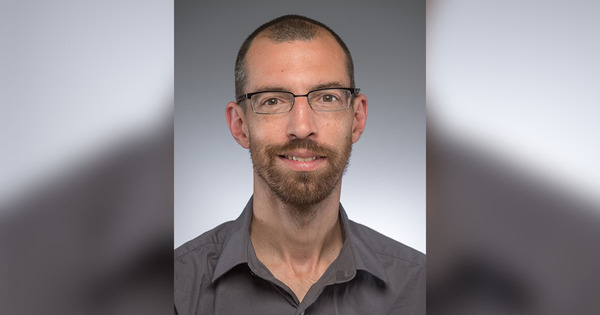
Brian Mulholland, a visiting assistant professor in the Department of Mathematics, on Wednesday asked 18 students in his History of Mathematics course, “We’re not having technical difficulties – we can see this?”
He had just written (a2 +ab+ab+b2) (a+B) on his iPad and displayed it through sharing his screen through the Zoom platform. Everyone nodded – they could all see his work.
Mulholland was relieved. Before e-learning started at the University of Notre Dame, he connected his office computer at home directly to his router, preparing to teach students in the new environment.
“I always record all my lectures via Zoom, in case students have a technical issue anyway,” he said. “I didn’t want to have any technical issues by going through WiFi.”
He and Kathryn Mulholland, a sixth-year graduate student in the Department of Mathematics, had both been teaching online mathematics courses during the past three summers. Because they were familiar with using Zoom and digital learning, they made a question-and-answer sheet for other mathematics faculty and have assisted the department through the transition in general.
“Our department was fantastic with everything,” Brian Mulholland said. “They ordered a bunch of Apple iPads and pencils, which professors can borrow for teaching, since writing is the best way to teach math.”
As a graduate associate of the Kaneb Center, Kathryn Mulholland was also able to share resources, and has been impressed with the level of initiative that many in the department have had by making their own videos and other materials.
“Everything seems to be going fine,” said Richard Hind, chair of the department and professor of mathematics. “Of course it’s not exactly like going to a classroom, but everything has been working well.”
The math help room has been continuing, and is open for several hours a day, most days of the week, Brian Mulholland said. Teaching assistants sign up for slots to staff the virtual room, and undergraduates can log into the rooms at any time for assistance.
Faculty office hours are now all on Zoom, which is a feature Hind believes could continue after the restrictions caused by COVID-19 lift. “Potentially, if a student is sick, or if his grandmother died, office hours can be done remotely,” he noted. The Mulhollands agreed that many students might prefer that method, particularly during winter months.
Kathryn Mulholland leads a tutorial through a course under the guidance of Annette Pilkington, professor of the practice in the Department of Mathematics. The class was already a “flipped” class, meaning students were given videos to watch before class and then attended lecture in person, where they completed their problem. Mulholland has structured her tutorial using breakout rooms, and said she feels the flipped nature of the course may be used more frequently in the future now that professors and students are more comfortable with video and Zoom.
Having to teach online forced Brian Mulholland to think more creatively for his mathematics in architecture course, which he teaches for the School of Architecture. His course had just started delving into the mathematics of Gothic style architecture, and he was able to meet with an architect who submitted a pitch for the reconstruction of Notre Dame Cathedral, which burned in Paris last summer.
“Hopefully we can have him go online and give his pitch to architecture students, and show them where Gothic style and their jobs intersect,” he said. “Now it won’t feel unnatural to say, let’s have a Zoom meeting with an architect – that would be great opportunity.”

Determining how to give exams online was the hardest thing about the switch to e-learning, according to Mark Behrens, the John and Margaret McAndrews Professor of Mathematics. Some are e-mailing exams to be read and printed out, and students will need to scan and send them back. Others are using the tools in Sakai or through an app, Web Assign, where students are given a window of time in which to take an exam and the allotted time begins when the student logs in, Hind said.
“The students have been very understanding and grateful,” Behrens said. “Our students did very well on their first exam— I know they have to do extra work to absorb the material under these circumstances.”